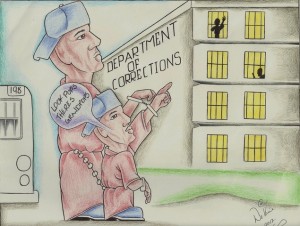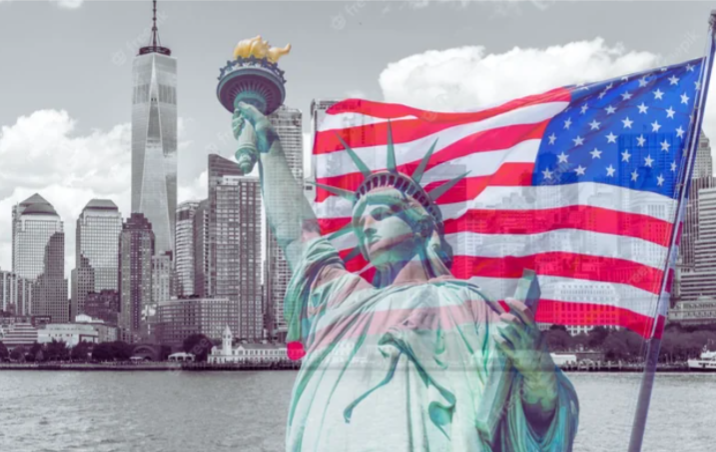(ThyBlackMan.com) “One picture,” Fred R. Bernard once aptly remarked, “Is worth a thousand words.” But, we need only a few words to describe an unsettling truth vividly depicted in the drawing shown here. On first glance this picture evokes visual images of cruelty, dehumanization, exploitation, racism, injustice, corruption, disenfranchisement, arbitrary punishment, and a host of other instruments of oppression people use to harm or exploit others. What do you see? Let’s look closer.
What a tragic thought: A man and his son handcuffed and shackled together; yet musingly delighted about seeing a senior family member whom they are not going inside to visit–rather to join in what is widely considered as America’s modern day form of slavery.
The inhumanity represented in this artwork should be disturbing to anyone with a conscience–but few are moved. The great American writer and philosopher, Ralph Waldo Emerson, gave a simple explanation for human indifference towards other human suffering when he wrote “What it does not see, what it does not live, it will not know.” The chilling reality of Emerson’s words can be used to describe the mindset of most Americans, especially those of the majority who are unaware of how U.S. political, legal and corporate entities work in tandem to perpetuate a cruel cycle of “Generational Incarceration.” And those who are aware of what Michelle Alexander describes as the “New Jim Crow” believe that most prisoners deserve the way they are mistreated–regardless of whether or not the policies and practices of the criminal justice system violates every principle of moral decency and fairness.
corporate entities work in tandem to perpetuate a cruel cycle of “Generational Incarceration.” And those who are aware of what Michelle Alexander describes as the “New Jim Crow” believe that most prisoners deserve the way they are mistreated–regardless of whether or not the policies and practices of the criminal justice system violates every principle of moral decency and fairness.
Another important reality that is hard to discern in this picture is the causes of generational incarceration. It is difficult for people to accept how generation after generation of under-education and sky high unemployment rates significantly determines the degree of criminality in urban communities. Numerous studies show how the unequal distribution of wealth, education, and political power essentially predetermines which segments in society will accept unlawful activities as a means of survival. Since none of us choose the socioeconomic status we are born in, we must ask ourselves: Are those incarcerated totally to blame? Or is society partially culpable?
I do not wish to give the impression that I believe that the U.S. prison system should be abolished. It has purpose. I’m only pointing out how political and legal authorities create laws that damage the social fibers in African American and other minority’s communities. It is as if they deliberately create policies and laws without any concern for the long-term ramifications these laws will have on low income, poorly educated societies.
America is a relatively well off country boasting the highest average income, yet it has the most flagrant economic class divisions. To see this, just drive a few blocks over, or turn on your local news channel. Our rugged individualism which is a by-product of our brand of market economics, promotes a callous indifference for the well-being of others. This ideology is captured raw in one of Kanye West’s songs: “I got mine, you get yours.” This selfish attitude fosters negativity and desperation. No wonder lower income younger people turn out to be violent predators and substance abusers, mimicking behaviors that promise that they will be ensnared by a criminal justice system that thrives off misery and unwise decisions.
In a derisory attempt to address this social problem, legislators harden the penalties of existing laws. Now, lawbreakers receive sentences that are disproportionate in degree of severity to the crime committed. Such laws create a ripple effect throughout many of the poorest communities. For instance, prisoners receiving unfairly long sentences often lose family connections. Consequently, when they return to society they are often bitter and they lack vital support systems essential to make a smooth integration back into society.
The problem of wholesale incarceration, moreover, is compounded by corruption. Increasing privatization allows corporate prison suppliers to receive lucrative no-bid contracts that permits them to sell prisoners inferior products at five times or more their retail value. In the Michigan Department of Corrections, for example, inmates are charged $3 for a fifteen minute, non-collect phone call. In other state department of corrections the rates are as high as $9. Such anti-competitive business practices allow prison contractors (like Westinghouse, Union Supply, Sprint and Keefe Group) to rake in monopoly profits, or “rents” as economist Joseph E. Stiglitz calls them.
Thus, private owners of prisons and supply contractors view prisoners as a precious commodity. This explains why more and more private owners are lobbying lawmakers to stiffen prison sentences. Crowded prisons maximize profits. But corruption is not limited to corporations and bureaucrats on the outside. Inside prison corruption is more vulgar.
Television shows like “Inside American Jails,” “America’s Hardest Prisons,” and “Women In Prison,” do not expose the brutality and dehumanizing treatment of prisoners in general. African American inmates, in particular, are subjected to even harsher abuse than non-Blacks mostly because of racism and partly because nine out of ten times they are held in remote correctional facilities, several hours drive away from their hometowns.
Often the staffs of these correctional facilities are 100% White. (Many guards privately admit that their first encounter with Blacks occurred when they were hired.) In addition, there are published cases that show how sexually depraved prison guards are convicted of raping female, male, and mentally handicapped prisoners. Records show that it is not uncommon for prison guards to get indicted for selling cocaine and heroin to prisoners. In fact, recently in a Pennsylvania state prison, numerous prison guards were arrested for running a drug ring inside the prison.
Look at the picture again. Now let’s try to re-draw a better one. There are more humane, effective ways to decrease the crime rate. We can begin by increasing funding for education and bringing back exported jobs. For a quarter of a century mass incarceration has not proven to be a deterrent to crime. Reform and rehabilitation, and continued family support are the answers; the essential elements that are needed in prisons. Incarceration should be utilized only as a last resort.
Staff Writer; L.C. DeVine
Official website; http://crimedivas.wordpress.com
This talented sister is also editor over at; http://NoFrillNews.org
















When I saw the title and started reading I was reminded of Yusef Shakur’s account of meeting his father in jail and learning from him there.
http://www.examiner.com/article/local-author-yusef-shakur-offers-window-as-escape-for-urban-youth
We do need to see that a different system is possible. The premise of the School-To-Prison Pipeline is very disturbing, that the system would intentionally under educate to drive young people toward crimes of opportunity and even petty offenses that take them out of having life outside, or in an extremely dangerous spot of defending staying out. It takes a community on the outside and on the inside to reform the system. It also requires getting the bounty off the heads of our young people. They are not chattel for the prison system.